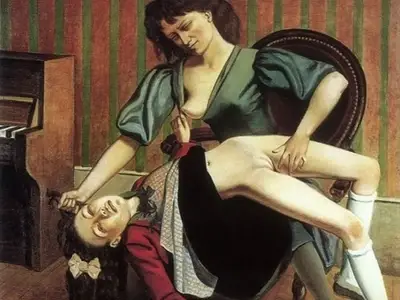Title of Artwork: “Guitar Lesson”

Artwork by Balthus
Year Created 1934
Summary of Guitar Lesson
The guitar in question is lying on the floor as the instructor grabs her teenage student’s hair and touches her (dangerously close to her bare vagina) as if she were an instrument to be played. When it was seen as part of Balthus’ first show in Paris, this disturbing depiction of paedophilia sparked a sensation. No one has ventured to place it on display since 1977 because it is both shocking and divisive. It has been shared between museums and collectors, but it has never been displayed. This would have enraged the late Balthus, who said that his work could only be seen and not written about.
All About Guitar Lesson
This is a great example of how his symbolic works caused some viewers to feel uncomfortable and is an example, if not the last one, of how he used young girls in his paintings. This work was originally presented during one of his earliest exhibitions in Paris, but was not on display in the public as it was last seen in New York in 1977 with the exposed lower body of a prepubescent girl and the hinting of a sexual alliance with the lady on whose lap she rested.
Although the title technically refers to the guitar in the front row of the composition, it is used in a more symbolic manner—the seated lady has her arms and hands as if she were playing the guitar, but the instrument is the body of a little girl. This work also comments on roles of authority and dominance: the young girl is submissionnly draped on the lap of a woman, and her facial and limp arms mean little helpings, although the hand of the girl reaching to hold on to the woman’s exposed breast suggests an ambiguity between a seeking of pleasure and a more conventional mother’s help. The sitting lady, on the other hand, controls the whole scene, and her expression and downward look imply power over a limp girl.
Here, even the painting’s draped posture refers to the historical works that preceded it; the unlifted body of the girl imitates numerous renditions of the Pieta in the lap of a lady. As Michelangelo’s Virgin Mary stares at her dead son with care, the mother is less passionate, more studied, and more predatory than loving in this picture. The dead face of Christ is presented up to a symbolic father/heaven, while Balthus’ daughter appears naked in the ambiguity of the scenario.
With the fact that Balthus was brought up in a creative family, it is probably not unexpected that, using a conventional figurative genre, he could push the boundaries of customised moral acceptance. Peter Schjeldahl, art critic of New York magazine: “Balthus traps us, because he can, in a moral dilemma.” “His beautifully subtle breaches of the taboo earned a permanent place for him, for his conservative figurative work, amid the mainly surrealist, libertine Parisian avant-garde of the nineteen-thirties.”
En.wikipedia.org, https://en.wikipedia.org/.
























